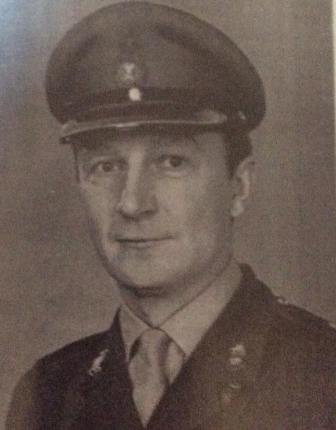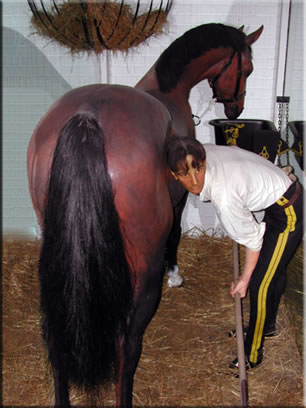John was commissioned in 1948 as a National Service Second Lieutenant into the 7th Hussars, then a RAC Training Regiment in Barnard Castle, until his discharge in February 1950, when he went to work in the City.

In August 1950 he was recalled to the colours with the outbreak of hostilities in Korea. He joined the 8th Hussars in Tidworth where he was quickly converted to the newly issued Centurion Mk3 as a tank commander and Troop Leader.
After World War 2 the Army had depleted in size and recruiting of regular troops was at an all-time low.
The 8th Hussars’ ranks were filled with numerous National Servicemen and Royal Armoured Corps reservists.
John was a Section Commander in Recce Troop, attached to ‘C’ Squadron with Major Henry Huth MC and Bar as Squadron Leader.
When in April 1951, the Chinese launched their massive spring offensive, 29 Brigade were called upon to hold the line in a rearguard action to allow the remainder of the United Nations Forces to regroup and reinforce the defensive line south of Seoul. John served with distinction and was wounded during the 3-day battle.
He was awarded the Military Cross for his exceptional gallantry.
The nickname of “Blood” was bestowed on him by Lt Col Sir Guy Lowther, Commanding Officer of the 8th Hussars in Korea, which would stick with him throughout his service. This was a joke – early on in Korea, John was feeling under the weather and went into the bar for a drink, went white as a sheet and fainted. So he got the nickname ‘Blood’. He didn’t mind his comrades calling him this.
On return to England, John was discharged, again to work in the City, but decided that he wanted to pursue a career in the Army and rejoined with a Regular Commission in the 7th Queen’s Own Hussars in late 1952. He served as a Troop Leader, Signals Officer, Assistant Adjutant, and Second in Command of ‘A’ Squadron, by now The Queen’s Own Hussars, with tours at the RAC Centre and the Yeomanry.
He returned to ‘A’ Squadron in Berlin and took over 1966 to command it in Berlin, Maresfield, then Crater during the last phase and withdrawal from Aden, where he was awarded a Mentioned In Despatches.
Following a tour as Senior Instructor at the Gunnery School, he commanded The Queen’s Own Hussars from 1971 to 74 in Germany with two tours in Northern Ireland – the first in the southern part with a composite force including A Squadron in armoured cars; then in 1973 in Belfast as the first cavalry regiment complete to go in the infantry role – all successful due to his meticulous planning, judgement and unfailing dry sense of humour – and resulting in a second Mention.
He was very smart and very professional: a most respected and well-liked Commanding Officer.
He then instructed at the Royal Military College of Science; and his last appointment was Commandant of the RAC Gunnery School in Lulworth, retiring in 1982.
John supported the Regiment, Museum and Association until his death in 2001. He was highly artistic, particularly as a fine sculptor, with interests in art, antiques, sculpture, and militaria. He was also a leading regimental historian and heritage expert.
He brought his artistic side into regimental life, such as writing and directing pantomimes in Münster and Berlin. When he took over ‘A’ Sqn in Berlin he was a kindred spirit to Michael Parker, particularly over the Parker production of Richard III, for which John made the two Queen’s Beasts one each side of the stage: Richmond greyhound and Clarence Black Bull. Tisha, who supported him most nobly throughout his career, was the Production Secretary.
Another notable contribution was, when CO at Hohne, designed the layout of a memorable photograph of the whole Regiment with all its vehicles. The perspective tapering to fit the frame meant that the line of Stalwarts at the back was twice as long as the front line of Chieftains.
Part of our heritage is our links, on which he was keen and gave erudite talks on Birmingham and on the Polish 2nd Corps in the Italian Campaign, and the Maid of Warsaw distinction.

He was the artistic lead to Robin Carnegie and others on the QOH Museum redevelopment at the time of the Tercentenary. The Stable Horse and Trooper Display, with mirrors at each side suggesting a row of stables, was his masterpiece, as well as ‘cascade’ layouts of objects for 1 and 2 WW displays, and the Timeline.
He led the design of the Tercentenary Collection, particularly influencing the prime item – the ‘Smoke Break Dragoon’ statuette. A perfectionist, he would not be rushed and went to endless trouble and his own expense to finalise a project.
For the QRH 1993 Amalgamation, he was the lead heritage advisor, a position given much credibility with both antecedent regiments from his expertise, but also his distinguished service and MC with 8H in Korea. He drew up the combined lists of Battle Honours and advised which to be primary on the Guidon; as well as on colours for items such as the Regimental Tie.
A true Queen’s Royal Hussar who had served in both the Irish and the Queen’s Own.


